2018 MERCEDES-BENZ CLA warning
[x] Cancel search: warningPage 56 of 326
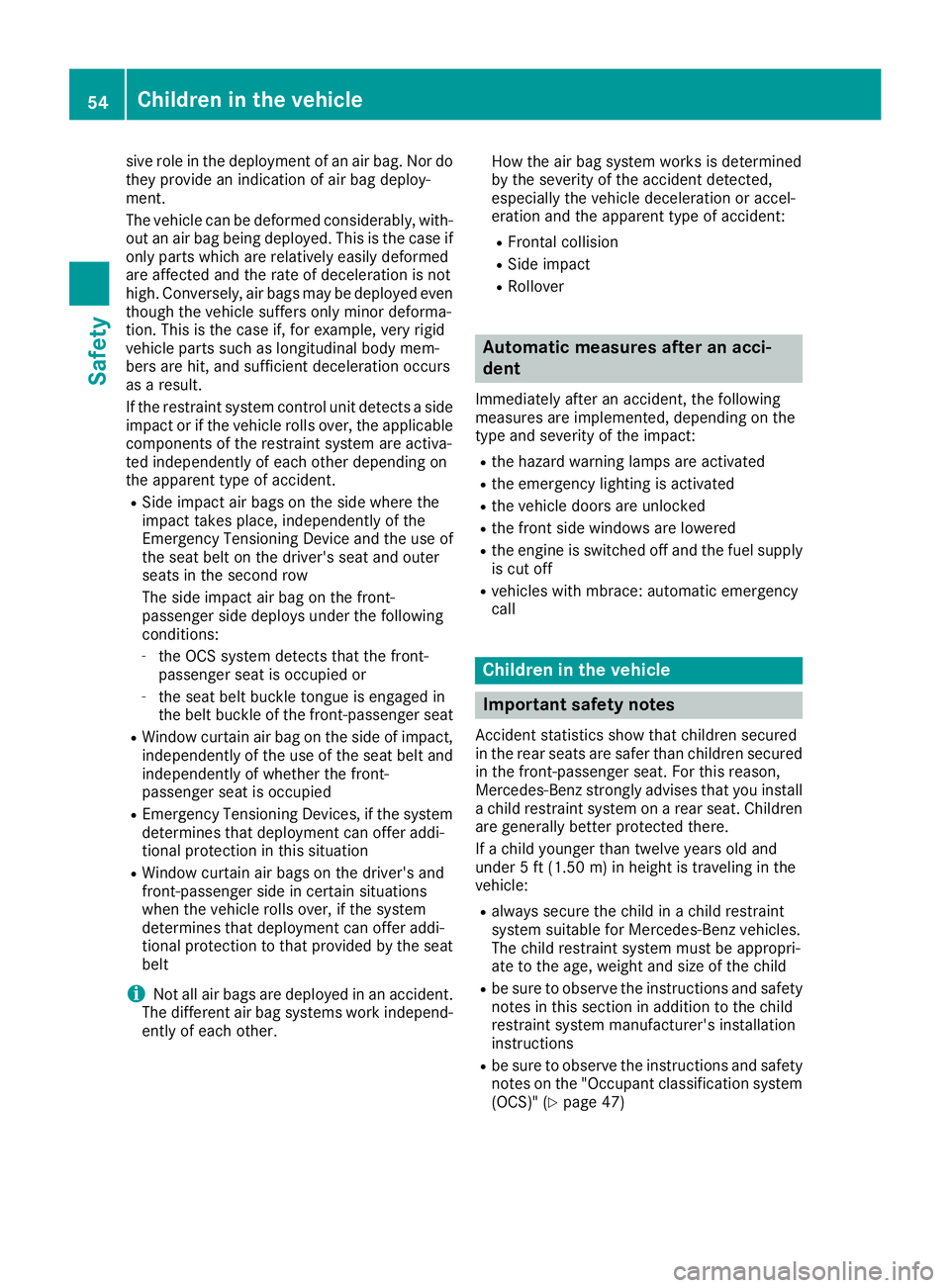
sive role in the deployment of an air bag. Nor do
they provide an indication of air bag deploy-
ment.
The vehicle can be deformed considerably, with-
out an air bag being deployed. This is the case if
only parts which are relatively easil yd eformed
are affected and the rate of deceleration is not
high. Conversely, air bags may be deployed even
though the vehicle suffers only minor deforma-
tion. This is the case if, for example, very rigid
vehicle parts such as longitudinal body mem-
bers are hit, and sufficient deceleration occurs
as ar esult.
If the restraint system control unit detects as ide
impact or if the vehicle rolls over, the applicable
component soft he restraint system are activa-
ted independently of each other depending on
the apparent type of accident. R
Side impact air bags on the side where the
impact takes place, independently of the
Emergenc yT ensioning Device and the use of
the seat belt on the driver's seat and outer
seats in the second row
The side impact air bag on the front-
passenger side deploy su nder the following
conditions: -
the OCS system detects that the front-
passenger seat is occupied or -
the seat belt buckle tongue is engaged in
the belt buckle of the front-passenger seat R
Window curtain air bag on the side of impact,
independently of the use of the seat belt and
independently of whether the front-
passenger seat is occupied R
Emergenc yT ensioning Devices, if the system
determines that deployment can offer addi-
tional protection in this situation R
Window curtain air bags on the driver's and
front-passenger side in certain situations
when the vehicle rolls over, if the system
determines that deployment can offer addi-
tional protection to that provided by the seat
belt
i Not all air bags are deployed in an accident.
The different air bag systems work independ-
ently of each other. How the air bag system works is determined
by the severity of the accident detected,
especially the vehicle deceleration or accel-
eration and the apparent type of accident: R
Frontal collision R
Side impact R
Rollover
Automatic measures after an acci-
dent Immediately after an accident, the following
measures are implemented, depending on the
type and severity of the impact: R
the hazard warning lamps are activated R
the emergency lighting is activated R
the vehicle doors are unlocked R
the front side windows are lowered R
the engine is switched off and the fuel supply
is cut off R
vehicles with mbrace: automatic emergency
call
Children in the vehicle
Important safety notes Accident statistics show that children secured
in the rear seats are safer than children secured
in the front-passenger seat. For this reason,
Mercedes-Benz strongly advises that you install
ac hild restraint system on ar ear seat. Children
are generally better protected there.
If ac hild younger than twelve years old and
under 5ft( 1.50 m) in height is traveling in the
vehicle: R
always secure the child in ac hild restraint
system suitable for Mercedes-Benz vehicles.
The child restraint system must be appropri-
ate to the age, weight and size of the child R
be sure to observe the instructions and safety
notes in this section in addition to the child
restraint system manufacturer's installation
instructions R
be sure to observe the instructions and safety
notes on the "Occupant classification system
(OCS)" ( Y
page 47)54
Children in the vehicle
Safety
Page 57 of 326
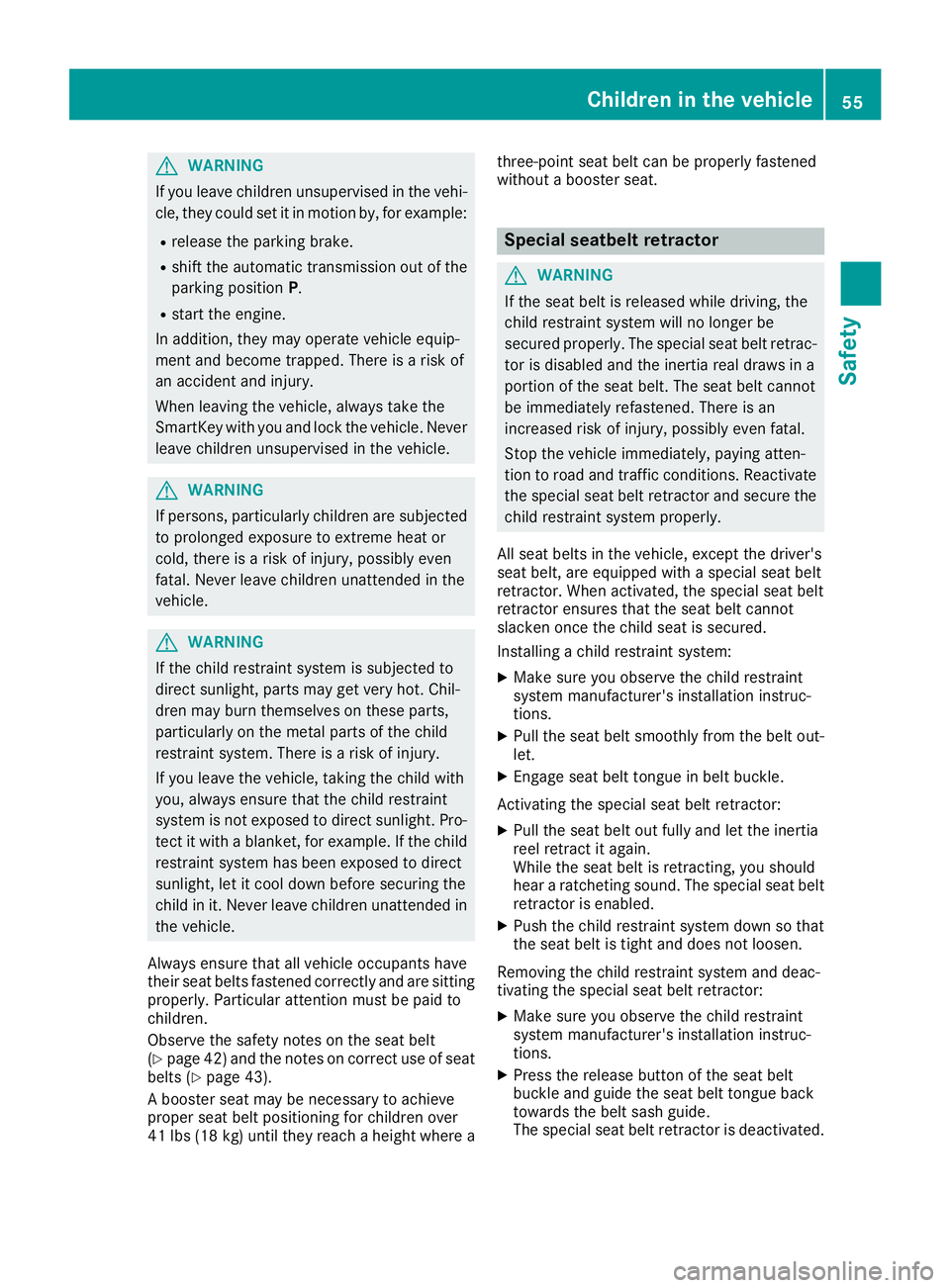
G WARNING
If you leave children unsupervised in the vehi-
cle, they coul ds et it in motion by, for example:R
release the parking brake. R
shift the automatic transmission out of the
parking position P .R
start the engine.
In addition, they may operate vehicl ee quip-
ment and become trapped. There is ar isk of
an accident and injury.
When leaving the vehicle, alway st ake the
SmartKey with you and lock the vehicle. Never
leave children unsupervised in the vehicle.
G WARNING
If persons, particularl yc hildren are subjected
to prolonged exposure to extreme hea to r
cold, there is ar isk of injury ,p ossibly even
fatal .N ever leave children unattended in the
vehicle.
G WARNING
If the child restraint system is subjected to
direct sunlight, parts may get very hot. Chil-
dren may burn themselves on these parts,
particularl yont he metal parts of the child
restraint system. There is ar isk of injury.
If you leave the vehicle, taking the child with
you ,a lway se nsure that the child restraint
system is not expose dtod irect sunlight. Pro-
tect it with ab lanket, for example. If the child
restraint system has been expose dtod irect
sunlight, let it cool dow nb efore securing the
child in it. Never leave children unattended in
the vehicle.
Always ensure that all vehicl eo ccupants have
their seat belts fastened correctly and are sitting
properly .P articular attention must be pai dt o
children.
Observe the safety notes on the seat belt
( Y
pag e4 2) and the notes on correct use of seat
belts ( Y
pag e4 3).
Ab ooster seat may be necessary to achieve
prope rs eat bel tp ositioning for children over
41 lbs (18 kg )u ntil they reach ah eight where a three-point seat bel tc an be properly fastened
without ab ooster seat.
Special seatbelt retractor
G WARNING
If the seat bel tisr eleased while driving, the
child restraint system wil lnol onger be
secure dp roperly .T he special seat bel tr etrac-
tor is disable da nd the inertia real draw sina
portion of the seat belt. The seat bel tc annot
be immediatel yr efastened. There is an
increased risk of injury ,p ossibly even fatal.
Stop the vehicl ei mmediately, paying atten-
tion to road and traffic conditions. Reactivate
the special seat bel tr etractor and secure the
child restraint system properly.
All seat belts in the vehicle, except the driver's
seat belt, are equipped with as pecial seat belt
retractor. When activated, the special seat belt
retractor ensure st hat the seat bel tc annot
slacken once the child seat is secured.
Installing ac hild restraint system: X
Make sure you observe the child restraint
system manufacturer's installation instruc-
tions. X
Pul lt he seat bel ts moothly from the bel to ut-
let. X
Engage seat bel tt ongue in bel tb uckle.
Activating the special seat bel tr etractor:X
Pul lt he seat bel to ut full ya nd let the inertia
reel retract it again.
Whil et he seat bel tisr etracting, you should
hear ar atcheting sound .T he special seat belt
retractor is enabled. X
Push the child restraint system dow nsot hat
the seat bel tist ight and does not loosen.
Removing the child restraint system and deac-
tivating the special seat bel tr etractor:X
Make sure you observe the child restraint
system manufacturer's installation instruc-
tions. X
Press the release button of the seat belt
buckle and guide the seat bel tt ongue back
toward st he bel ts ash guide.
The special seat bel tr etractor is deactivated.Children in the vehicle 55
Safety Z
Page 58 of 326

Child restraint system The use of seat belt sa nd child restraint systems
is required by law in: R
all 50 states R
th eU .S .t erri toriesR
th eD istrict of ColumbiaR
all Canadian provinces
If you install ar earward-facing child restraint
system on th ec ente rr ear seat ,t he rear arm rest
must be folded back as far as possible.
You can obtain further informatio na bout the
correc tc hi ld restraint system from any author-
ize dM ercedes-Ben zC enter.
G WARNING
If th ec hi ld restraint system is installed incor-
rectly on as uitable seat ,itc anno tp rotect as
intended. The child canno tt he nber estrained
in th ee vent of an accident, heav yb raking or
sudde nc ha nges of direction .T her eisa n
increased ris kofi njury, possibly eve nf atal.
Mak es ure that you observ et he child restraint
system manufacturer' si nstallatio ni nstruc-
tions and th en otes on use. Pleas ee ns ure,
that th eb ase of th ec hi ld restraint system is
always restin gc ompletely on th es eat cush-
ion .N ever plac eo bjects, e.g .c ushions, under
or behin dt he child restraint system. Only use
child restraint systems wit ht he original cover
designe df or them. Only replace damaged
covers wit hg enuine covers.
G WARNING
If th ec hi ld restraint system is installed incor-
rectly or is no ts ecured, it can com el oos ei n
th ee vent of an accident, heav yb raking or a
sudde nc ha ng eind irection .T he child
restraint system coul dbet hr own about ,s tr ik-
ing vehicle occupants. Ther eisani ncreased
ris kofi njury, possibly eve nf atal.
Always install child restraint systems prop-
erly, eve nift he ya re no tb ein gu sed. Make
sure that you observ et he child restraint sys-
te mm anufacturer' si nstallatio ni nstructions.
You will fin df urther informatio nons to wing
objects, luggag eorl oads unde r" Loading guide-
lines" ( Y
page 237). G WARNING
Child restraint systems or their securin gs ys-
tems whic hh ave been damaged or subjected
to al oad in an acciden tc an no longer protect
as intended. The child canno tt he nb e
restraine dint he event of an accident, heavy
braking or sudde nc ha nges of direction .T here
is an increased ris kofi njury, possibly even
fatal.
Replac ec hi ld restraint systems whic hh ave
been damaged or subjected to al oad in an
acciden tass oon as possible. Hav et he secur-
ing systems on th ec hi ld restraint system
checked at aq ualified specialist workshop,
before you install ac hi ld restraint system
again.
The securin gs ystems of child restraint systems
are: R
th es eat belt system R
th eL AT CH-type (ISOFIX) securin gr ingsR
th eT op Tether anchorages
If it is absolutely necessary to carry ac hi ld on
th ef ront-pa ssenger seat ,bes ure to observ et he
informatio nont he "Occupan tC lassification
Syste m( OCS)" ( Y
page 47) .T her ey ou will also
fin di nformatio nond eactivatin gt he front-
passenger fron ta ir bag.
All child restraint systems must mee tt he fol-
lowin gs ta ndards: R
U.S. Federal Motor Vehicle Safet yS ta ndards
21 3a nd 225 R
Canadian Motor Vehicle Safet yS ta ndards
21 3a nd 210.2
Confirmation that th ec hi ld restraint system cor-
responds to th es ta ndards can be foun dona n
ins truc tion label on th ec hi ld
restraint system.
This confirmation can also be foun dint he instal-
lation instruction st ha ta re included wit ht he
child restraint system.
Observ et he warning labels in th ev ehicle inte-
rior and on th ec hi ld restraint system.56
Children in th ev ehicle
Safety
Page 59 of 326
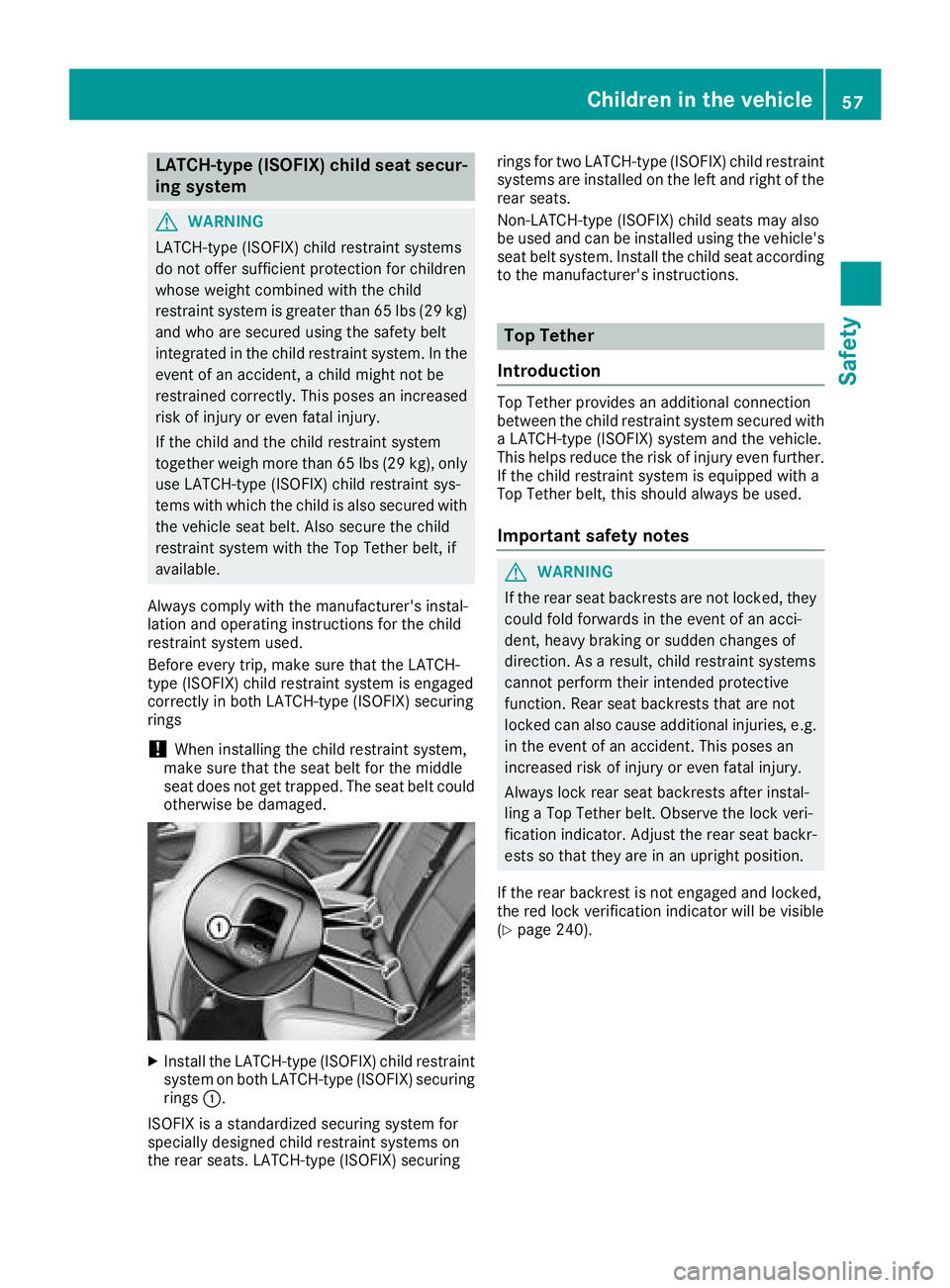
LATCH-typ e( ISOFIX) child seat secur-
ing system
G WARNING
LATCH-type (ISOFIX) child restraint systems
do not offer sufficient protection for children
whose weight combine dw ith th ec hild
restraint system is greater than 65 lbs (29 kg)
and who are secured usin gt he safety belt
integrated in th ec hild restraint system. In the
even tofana ccident, ac hild migh tn ot be
restrained correctly. This poses an increased
risk of injury or even fatal injury.
If th ec hild and th ec hild restraint system
together weigh mor et ha n65l bs (29 kg), only
use LATCH-type (ISOFIX) child restraint sys-
tem sw ith whic ht he child is also secured with
th ev ehicle seat belt .A ls os ecure th ec hild
restraint system with th eT op Tether belt ,i f
available.
Always comply with th em anufacturer' si nstal-
latio na nd operatin gi nstruction sf or th ec hild
restraint system used.
Before ever yt ri p, mak es ure that th eL AT CH-
type (ISOFIX) child restraint system is engaged
correctly in bot hL AT CH-type (ISOFIX) securing
rings
! When installing th ec hild restraint system,
mak es ure that th es eat belt for th em iddle
seat does not get trapped. The seat belt could
otherwise be damaged.
X
Install th eL AT CH-type (ISOFIX) child restraint
system on bot hL AT CH-type (ISOFIX) securing
rings �C .
ISOFI Xisas ta ndardized securin gs ystem for
specially designed child restraint systems on
th er ear seats. LATCH-type (ISOFIX) securing rings for two LATCH-type (ISOFIX) child restraint
systems are installe dont he left and righ toft he
rear seats.
Non-LATCH-type (ISOFIX) child seat sm ay also
be used and can be installe du sin gt he vehicle's
seat belt system. Install th ec hild seat according
to th em anufacturer' si nstructions.
Top Tether
Introduction Top Tether provides an additional connection
between th ec hild restraint system secured with
aL AT CH-type (ISOFIX) system and th ev ehicle.
This helps reduc et he risk of injury even further.
If th ec hild restraint system is equipped with a
Top Tether belt ,t hi ss hould always be used.
Important safety notes
G WARNING
If th er ear seat backrests are not locked ,t he y
could fold forwards in th ee ven tofana cci-
dent, heavy braking or sudden changes of
direction. As ar esult, child restraint systems
cannot perform their intended protective
function .R ear seat backrests that are not
locked can also cause additional injuries ,e .g.
in th ee ven tofana ccident. This poses an
increased risk of injury or even fatal injury.
Always lock rear seat backrests after instal-
ling aT op Tether belt .O bserve th el oc kv eri-
ficatio ni ndicator. Adjust th er ear seat backr-
est ssot ha tt he ya re in an uprigh tp osition.
If th er ear backres tisn ot engaged and locked,
th er ed lock verificatio ni ndicator will be visible
( Y
page 240).Children in th ev ehicle 57
Safety Z
Page 61 of 326
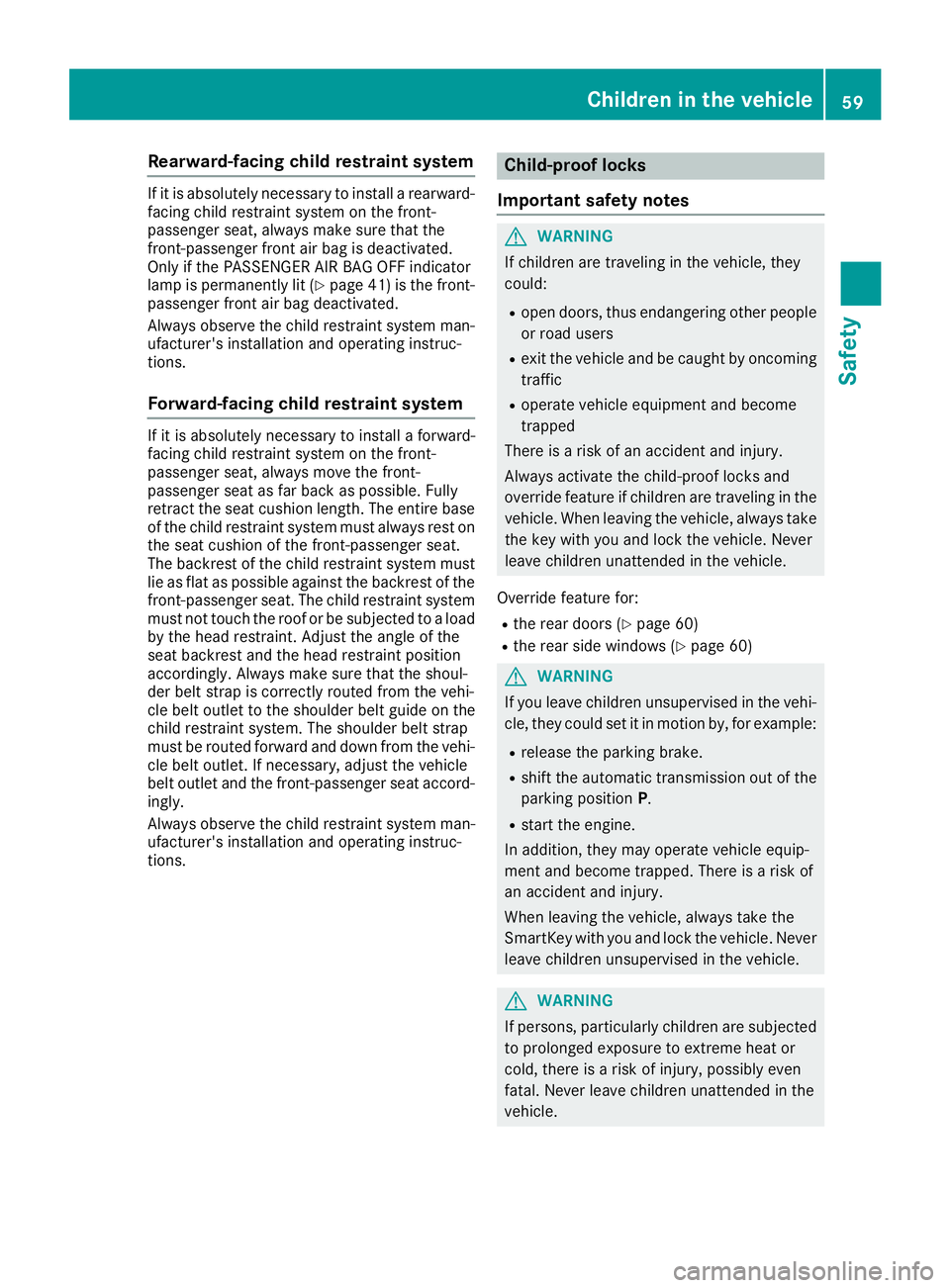
Rearward-facin gc hild restraint systemIf it is absolutely necessary to install ar earward-
facing child restraint system on the front-
passenger seat, always make sure that the
front-passenger front ai rb ag is deactivated.
Only if the PASSENGER AIR BAG OFF indicator
lamp is permanently li t( Y
page 41 )i st he front-
passenger front ai rb ag deactivated.
Alway so bserve the child restraint system man-
ufacturer's installation and operating instruc-
tions.
Forward-facing child restraint system If it is absolutely necessary to install af orward-
facing child restraint system on the front-
passenger seat, always move the front-
passenger sea ta sf ar back as possible .F ully
retract the sea tc ushio nl en gth. The entir eb as e
of the child restraint system mus ta lway sr es to n
the sea tc ushio noft he front-passenger seat.
The backrest of the child restraint system must
li easf la ta sp ossible against the backrest of the
front-passenger seat. The child restraint system
mus tn ot touch the roo forbes ub jecte dtoal oa d
by the hea dr estraint. Adjust the angle of the
sea tb ac krest and the hea dr estraint position
accordingly .A lway sm ake sure that the shoul-
der bel ts tra pisc orrectly routed from the vehi-
cle bel to ut let to the shoulder bel tg uide on the
child restraint system. The shoulder bel ts trap
mus tb er outed forward and dow nf rom the vehi-
cle bel to ut let. If necessary, adjust the vehicle
bel to ut let and the front-passenger sea ta ccord-
ingly.
Alway so bserve the child restraint system man-
ufacturer's installation and operating instruc-
tions. Child-proof locks
Important safety notes
G WARNING
If children are traveling in the vehicle, they
could: R
ope nd oors, thu se ndangering othe rp eople
or roa du se rs R
exi tt he vehicl ea nd be caught by oncoming
traffic R
operate vehicl ee quipment and become
trapped
There is ar is kofana ccident and injury.
Alway sa ctivate the child-proof locks and
overrid ef eature if children are traveling in the
vehicle. Whe nl ea ving the vehicle, always take
the key with yo ua nd lock the vehicle. Never
leave children unattende dint he vehicle.
Overrid ef eature for: R
the rea rd oors ( Y
page 60) R
the rea rs id ew in dow s( Y
page 60)
G WARNING
If yo ul ea ve children unsupervised in the vehi-
cle ,t hey could set it in motion by ,f or example:R
release the parking brake. R
shift the automatic transmissio no ut of the
parking position P . R
star tt he engine.
In addition, they may operate vehicl ee quip-
ment and become trapped .T here is ar is ko f
an accident and injury.
Whe nl ea ving the vehicle, always take the
SmartKey with yo ua nd lock the vehicle. Never
leave children unsupervised in the vehicle.
G WARNING
If persons ,p ar ticularly children are subjected
to prolonged exposure to extreme hea to r
cold, there is ar is kofi njury, possibly even
fatal. Neve rl ea ve children unattende dint he
vehicle.Childre nint he vehicle 59
Safety Z
Page 62 of 326
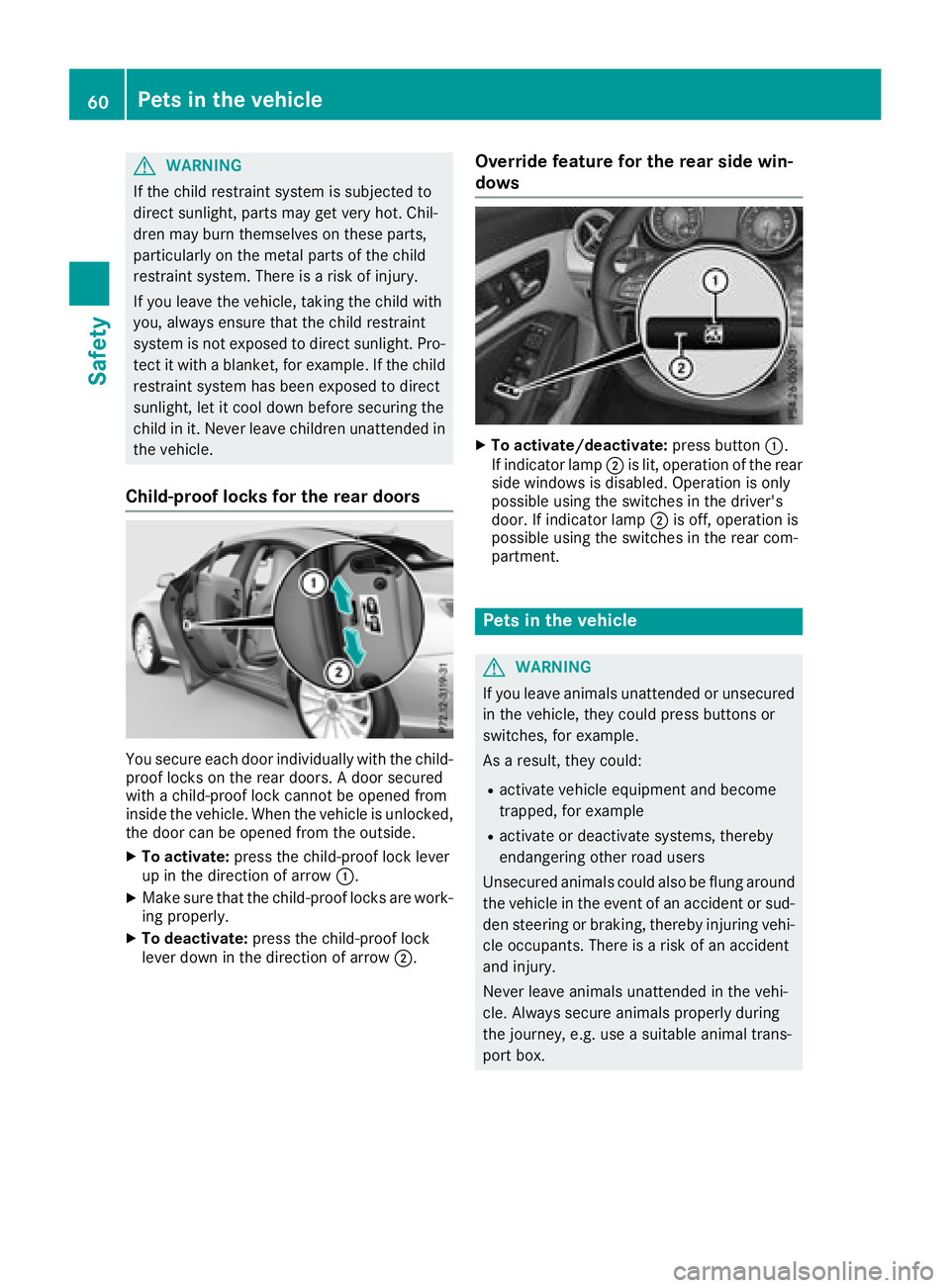
G WARNING
If the child restraint system is subjected to
direct sunlight, parts may get very hot. Chil-
dren may burn themselves on these parts,
particularl yont he metal parts of the child
restraint system. There is ar isk of injury.
If you leave the vehicle, taking the child with
you ,a lway se nsure that the child restraint
system is not expose dtod irect sunlight. Pro-
tect it with ab lanket, for example. If the child
restraint system has been expose dtod irect
sunlight, let it cool dow nb efore securing the
child in it. Never leave children unattended in
the vehicle.
Child-proof locks for the rear doors
You secure each door individually with the child-
proof locks on the rear doors. Ad oor secured
with ac hild-proof lock cannot be opened from
insid et he vehicle. When the vehicl eisu nlocked,
the door can be opened from the outside. X
To activate: press the child-proof lock lever
up in the direction of arrow �C .X
Make sure that the child-proof locks are work-
ing properly. X
To deactivate: press the child-proof lock
leve rd ow nint he direction of arrow �D . Override feature for the rear side win-
dows X
To activate/deactivate: press button �C .
If indicator lamp �D is lit, operation of the rear
side windows is disabled. Operation is only
possible using the switches in the driver's
door. If indicator lamp �D is off, operation is
possible using the switches in the rear com-
partment.
Pets in the vehicle
G WARNING
If you leave animals unattended or unsecured
in the vehicle, they coul dp ress buttons or
switches, for example.
As ar esult, they could: R
activate vehicl ee quipment and become
trapped, for example R
activate or deactivate systems ,t hereby
endangering other road users
Unsecure da nimals coul da ls obef lung around
the vehicl eint he event of an accident or sud-
den steering or braking, thereby injuring vehi-
cle occupants. There is ar isk of an accident
and injury.
Never leave animals unattended in the vehi-
cle. Always secure animals properly during
the journey ,e .g. use as uitable anima lt rans-
port box.60
Pets in the vehicle
Safety
Page 63 of 326

Drivin gs af et ys ystems
Overview of drivin gs af et ys ystemsIn this section ,y ou will fin di nformati on about
th ef ol lowin gd rivin gs afet ys ystems :R
AB S( A nti-lock B rakin g S ystem)
( Y
page 61) R
BA S( B rak e A ssist S ystem) ( Y
page 61)R
Active Brak eA ss is t( Y
page 62 )R
ES P ®
( E lectronic S ta bility P ro gram)
( Y
page 64) R
EB D( E lectroni c B rak ef orce D istribution )
( Y
page 67 )R
ADAPTIV EB RAKE ( Y
page 68 )R
STEE RC ONTROL ( Y
page 68)
Important safet yn otesIf you fail to adapt your drivin gs ty le or if you are
inattentive ,t he drivin gs afet ys ystems can nei-
ther reduce th er is kofana cciden tn or override
th el aws of physics. Driving safet ys ystems are
merely aids designed to assist driving. You are
responsible fo rm aintainin gt he distanc etot he
vehicle in front, fo rv ehicle speed, fo rb raking in
goo dt im e, and fo rs ta yin ginl ane. Always adapt
your drivin gs ty le to suit th ep revailin gr oa da nd
weather condition sa nd maintain as af ed istanc e
from th ev ehicle in front. Drive carefully.
The drivin gs afet ys ystems described only wor k
as effectively as possible when there is ade-
quat ec ontac tb etween th et ir es and th er oa d
surface. Please pay special attention to th e
note sont ir es ,r ecommended minimum tire
tread depths, etc. ( Y
page 288).
In wintr yd rivin gc onditi ons, always use winte r
tires (M+ St ir es )a nd if necessary ,s now chains.
Onl yint hi sw ay will the driving safety systems
describe dint hi ss ection work as effectively as
possible.
ABS (Anti-lock Brakin gS ystem)
General information
ABS regulate sb rake pressure in such aw ay that
the wheels do not lock when yo ub rake. This
allows yo utoc ontinue steering the vehicl ew he n
braking. The �% ABS warning lamp in the instrument
cluster lights up when the ignition is switched
on. It goe so ut when the engine is running.
ABS works from as peed of abou t5m ph
(8 km/h), regardless of road-surface conditions.
ABS works on slippery surfaces, eve nw he ny ou
onl yb rake gently.
Important safety notes
i Observe the "Important safety notes "s ec-
tio n( Y
page 61).
G WARNING
If ABS is faulty ,t he wheels could lock when
braking .T he steerability and braking charac-
teristic sm ay be severely impaired .A ddition-
ally ,f urther driving safety system sa re deac-
tivated .T here is an increased danger of skid-
ding and accidents.
Driv eonc arefully. Hav eA BS checked imme-
diately at aq uali fied specialist workshop.
Whe nA BS is malfunctioning ,o the rs ys tems,
including driving safety systems, will also
become inoperative. Observe the information
on the ABS warning lamp ( Y
page 220 )a nd dis-
play messages which ma ybes hown in the
instrument cluster ( Y
page 192).
Braking X
If ABS intervenes: continue to depress the
brake peda lv igorously unti lt he braking sit-
uatio ni so ver. X
To make af ul lb rake application: depress
the brake peda lw it hf ul lf orce.
If ABS intervene sw he nb raking ,y ou will fee la
pulsing in the brake pedal.
The pulsating brake peda lc an be an indication
of hazardou sr oa dc onditions, and functions as a
reminder to take extra car ew hile driving.
BAS (Brak eA ssis tS ystem)
General information
BAS operates in emergency braking situations.
If yo ud ep ress the brake peda lq ui ckly, BAS
automaticall yb oo sts the braking force ,t hus
shortening the stopping distance.Driving safety systems 61
Safety Z
Page 64 of 326

Important safety notes
i Observ et he "Importan ts afet yn otes "s ec -
tion ( Y
page 61).
G WARNIN G
If BA Sism alfunctioning ,t he braking distanc e
in an emergenc yb raking situation is
increased. Ther eisar is kofana ccident.
In an emergenc yb raking situation ,d epress
th eb rak ep edal wit hf ull force .A BS prevents
th ew heels from locking.
Braking X
Kee pt he brak ep edal firmly depressed until
th ee mergenc yb raking situation is over.
AB Sp revents th ew heels from locking.
The brakes will function as usual once you
release th eb rak ep edal .B AS is deactivated.
Active Brak eA ssist
General information
i Observ et he "Importan ts afet yn otes "s ec -
tion ( Y
page 61).
Active Brake Assist consist sofad istanc ew arn -
ing function wit hana utonomous braking func-
tion and situation-dependen tb raking assis-
tance
Active Brake Assist can help you to minimiz et he
ris kofac ol lision wit ht he vehicl et ra veling in
fron torr educe th ee ffects of suc hac ol lision .
If Active Brake Assist detects that there is ar is k
of collision ,y ou will be warned visually and
acoustically. If you do no tr eac ttot he visual and
audible collision warning ,a utonomous braking
can be initiate dinc riti cal situations. If you apply
th eb rak ey ourself in ac riti cal situation ,A da p-
tive Brake Assist support sy ou wit hs ituation -
dependen tb raking assistance.
Important safety notes
Detection of hazardous situation sc an be par-
ticularly impaired if: R
there is dirt on th es ensor sora nythin ge lse
covering th es ensor sR
there is snow or heav yr ainR
there is interferenc ebyo th er radar source s R
there are stron gr adar reflections, for exam-
ple in parking garages R
an arrow vehicl eist ra veling in front, e.g. a
motorbike R
av ehicl eist ra veling in fron tonad ifferen tl in eR
you are driving an ew vehicl eors ervicing on
th eA ctiv eB ra ke Assist system has jus tb een
carrie do ut
Observ et he important safet yn otes in th e
"Breaking-in notes" section ( Y
page 121).
Followin gd amag etot he fron te nd of th ev ehicle,
hav et he configuration and operation of th e
radar sensor checke dataq ualified specialist
workshop. This also applie stoc ol lision satl ow
speeds wher enov isible damag etot he fron to f
th ev ehicl eisa pparent.
Activating/deactivating Active Brake Assist is active after every ignition
cycle.
You can activat eord eactivat eA ctiv eB ra ke
Assist ( Y
page 185) in th eo n-bo ard computer.
When deactivated, th ed istanc ew arning func-
tion and th ea utonomous braking function are
also deactivated.
If Active Brake Assist is deactivated, th e �